Our Living Planet
First published in Sanctuary Asia,
Vol. 36
No. 12,
December 2016
Meet the men and women who represent the very best of conservation and Earth-patriotism. They have assumed the position of Earth-protectors and are a source of inspiration for millions. Their extraordinary commitment has often led to personal trauma and stress for their families, but their resolve and determination has ended up saving the last of our wilds. The Sanctuary Wildlife Awards celebrates their work, honours their purpose and records their contribution to the future of life on Earth.
Lifetime Service Award
S. E. H. Kazmi
One of my earliest memories is walking in tow of Abba and his men in the forests of the Palamau Tiger Reserve while they tried controlling a forest fire that had engulfed a hillock. Barely four years old then, I was not allowed near the site, but I remember watching him trek up the hill to oversee the firefighting. His entire career has perhaps been one great uphill trek against the forces that wish to destroy the natural world in a conflict-ridden landscape, while simultaneously standing shoulder to shoulder with the poorest of poor.
His reports against the Kutku dam and his unflinching support towards the affected villagers played a key role in stalling the ill-conceived project. His sustained crackdowns against poaching gangs and illegal Katha smugglers in Palamau would eventually culminate in a bid on his life in 1998. His negotiations with MCC ensured that they handed him 136 kg. of ivory and a leopard skin recovered by them. Even the Army was forced to give up on the proposed Netarhat field firing range at the southern end of Palamau when he refused to give the requisite clearances. The Horilong UG mining project too had to be abandoned for Daltonganj (South) Division’s upright DFO would not bend. At the same time, he earned the respect of the locals due to his honesty, people-friendly projects, warmth and friendliness. This translated into goodwill among the Naxal rebels too, who lorded over the state’s forests, so much so that in 2003 the CPI (Maoist) gave him an abhaydaan (official proclamation of safe passage through all rebel-controlled areas).
In 1998, he was transferred to Hazaribagh, where his battles with the coal mining mafia are well remembered. He also ensured the proposed Hazaribagh-Koderma railway line was realigned to save the imperiled Hazaribagh Wildlife Sanctuary. The compensation received under FCA was used to carry out a string of people-friendly work, for which villagers in Hazaribagh are still grateful.
In the last leg of his career, Abba requested to be returned to the place he had loved the most, Palamau. He joined as its Field Director in 2011, when the reserve was in shambles. Despite being crippled by a staggering staff vacancy, he and his men managed to slowly bring back some semblance of order. He would camp alone in abandoned field positions, rebuild destroyed infrastructure, resurrect wireless networks, re-establish mediation channels with rebels, walk miles with the trackers, rekindle old friendships in remote villages and make new ones. He initiated the first camera-trapping exercise in Palamau and within months, the first images of tigers in more than 15 years and other myriad wildlife (including some thought to have gone extinct) surfaced. By the end of 2011, the men returned to reoccupy their field posts. He also steadfastly denied security forces the use of departmental infrastructure for anti-insurgency operations in order to protect his staff and the infrastructure from a Naxal backlash. He encouraged young researchers to come and work in Palamau, even sharing his official residence with them. All this resulted in the first ever digitisation of field data, significant leaps in field research and addition of new species.
While he never admits it, I personally saw the miraculous resurrection of Palamau during his tenure. Unfortunately, soon after he was transferred in late 2014 due to the government being apprised by the police of a plan being hatched to eliminate him (by the same group responsible for the 1998 blast), many of the gains made were lost. But not all. A few weeks before his retirement, he was informed by a researcher he had appointed that they had camera-trapped otters in Palamau, the first record of the mammal in Jharkhand in 119 years. And so, hope still floats for the tiger reserve, even if barely. Abba and his team played their part in safeguarding our wild edens, and they played it well. It is now time for us to play our parts.
By Raza Kazmi, Jharkhand-based conservationist
Wildlife Service Awards
Lobsang Gyatso

WILDLIFE SERVICE AWARD Lobsang Gyatso aka ‘Anna’ Lama is best-known for his unflinching defence of Arunachal Pradesh’s natural heritage and his courageous opposition to the highly-destructive Nyamjang Chhu hydroelectric project. Photo Courtesy: Lobsang Gyatso.
Rescuing helicopter crash victims in Tawang in 2011 changed the course of Lama Lobsang Gyatso’s life – drawing him from the monastery to active social engagement in the Tawang region of Arunachal Pradesh. Called ‘Anna’ Lama because of his fearless fight against corruption and rapacious development, his best-known contribution has been the campaign to protect the rivers, wildlife and culture of Tawang, home to the Buddhist Monpa community. Along with other Lamas and lay citizens of Tawang, this campaign has been spear-headed through the Save Mon Region Federation (SMRF), an organisation set-up to safeguard the ecological and socio-cultural security of the Mon-Tawang region. In response to an appeal filed by the SMRF, the National Green Tribunal (NGT) in April 2016 suspended the environmental clearance of the 780 MW Nyamjang Chhu hydroelectric project, which directly impacted a three kilometre stretch of the Nyamjang Chhu river, a critical wintering site of the vulnerable Black-necked Crane, one of only two such sites in India.
Locals consider the Black-necked Crane an embodiment of the sixth Dalai Lama, Tsangyang Gyatso, who was a local Monpa from Tawang and wrote about the majestic bird in his poetry. Since 2012, SMRF, led by Lama Gyatso, has fought the battle to protect Tawang’s rivers and culture at various levels – local rallies and campaigns, meeting parliamentarians in Delhi (resulting in a debate in the Rajya Sabha on the issue in May 2012), reporting environment and forest violations to the MoEFCC, media advocacy, community mobilisation, legal action and documentation of culturally and ecologically-sensitive sites affected by certain destructive hydroelectric projects. This included photographing the elusive red panda in proposed project-affected areas. The lamas in SMRF have also been unafraid to ask questions of authorities within the monastic institutions, which were silently watching the destruction of culture and ecology in the Tawang river basin.
Within weeks of the NGT verdict in favour of SMRF, Lama Gyatso was arrested when he was helping local villagers expose corruption in an under construction small hydropower project. Supporters demanding his release were shot at, leading to the death of two people in May 2016. Despite the major setback to the movement, Lama Lobsang Gyatso and SMRF continue their fearless battle to protect the rivers, wildlife and culture of Tawang. The public backlash after the deaths has forced the state government to take on board the crucial concerns raised by SMRF. Today, many villages in the area have also adopted Gram Sabha resolutions against destructive projects impacting cultural sites, livelihoods and wildlife species.
By Neeraj Vagholikar, Kalpavriksh
Jigmet Takpa, IFS
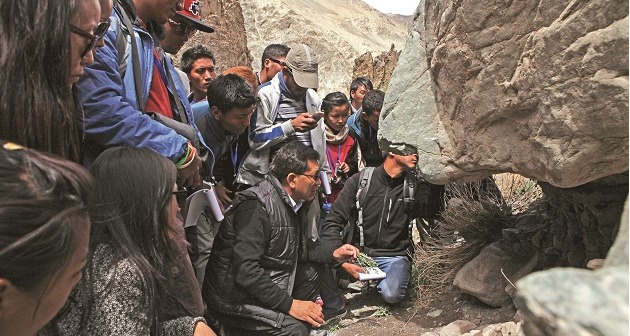
WILDLIFE SERVICE AWARD As one of the pioneers of Project Snow Leopard and a multitude of other initiatives aimed at improving rural livelihoods, Indian Forest Service officer Jigmet Takpa has transformed local attitudes towards wildlife in Ladakh. Photo Courtesy: Jammu and Kashmir Forest Department.
More than a decade ago, I had my first opportunity to visit Ladakh, the land of Lamas, snow leopards, urials and Black-necked Cranes. On that trip, I met Jigmet Takpa, a fine Indian Forest Service (IFS) officer from the 1990 batch, who had grown up in Ladakh as a native, and used his experience to develop programmes that ensured engagement between local communities, scientists and government. At that time he was coordinating the preparation of a roadmap for the progress of the Ladakh region with the Ladakh Autonomous Hill Development Council – the Ladakh Vision Document 2025. Since then I have followed his work and found him to be inspirational. Conservation programmes must essentially work closely with local communities, and Mr. Takpa has done this with great skill. Economic losses caused by human-wildlife conflict often erode the reverence of species and deplete tolerance towards conservation in general. Mr. Takpa’s work on innovative conflict resolution programmes that reduce monetary losses and improve tolerance of the communities, and efforts to improve their livelihoods through alternatives such as ecotourism has borne great results. Today, community members acknowledge the important role of the snow leopard, the apex predator of the Asian mountain ecosystem, as a barometer of the health of the ecosystem it thrives in, and as a cultural mascot of wildlife in the mountains. Other critical needs such as energy security through renewable sources is also improving the overall welfare of the people. Over the years, innovative, integrated conservation models in the snow leopard landscape being implemented under his leadership have been widely acclaimed and lauded for not only reducing human-wildlife conflict but also for building a constituency for wildlife conservation. Mr. Takpa has played important roles in several initiatives within Ladakh. From drafting management plans for the Hemis National Park to designing micro-level planning of the Changthang region and scaling up schemes of ecotourism through home-stays, eco-guides and camping and waste management projects, Mr. Takpa has several feathers in his cap.
Takpaji, as he is fondly known among his peers and colleagues, continues to play an important role in shaping the wildlife conservation, ecotourism and development landscape of Ladakh. His role in developing MoEFCC’s flagship programme for high altitude conservation – Project Snow Leopard, has been pivotal. He also serves on the Jammu and Kashmir State’s Biodiversity Board, and is the Director of the Ladakh Renewable Energy Development Agency apart from being the Chief Conservator of Forest (Wildlife), Ladakh.
By Koustubh Sharma, Senior Regional Ecologist, Snow Leopard Trust
Tiasa Adhya
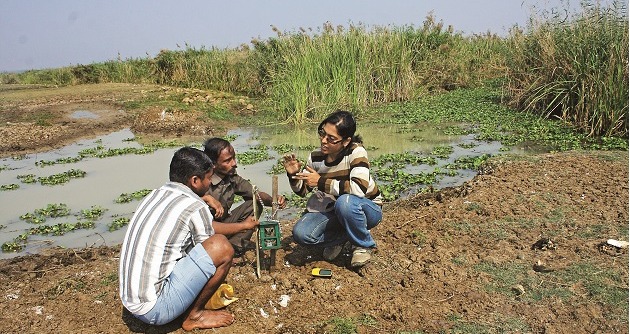
WILDLIFE SERVICE AWARD A wildlife biologist by training and a conservationist at heart, Tiasa Adhya’s persistent efforts to highlight the plight of the fishing cat and address problems of habitat destruction, conflict and retaliatory killings in West Bengal are truly commendable. Photo Courtesy: Partha Dey.
Though so-called charismatic megafauna have captivated humans, their smaller, less charismatic but no less important counterparts remain largely unknown to common people. Tiasa realised that her goal in life is to contribute to the conservation movement through conducting wildlife research, writing, and proactive threat-reduction programmes. Being a wildlife biologist by training and a conservationist at heart, her constant endeavour has been to fill the gap between theoretical knowledge and conservation practice.
Tiasa has achieved this by conducting sound research and by implementing science-based conservation efforts by involving common people from many walks of life.
Her goal is to take a conscious ethical stand for conservation of the only tropical wetland felid in South Asia – the fishing cat.
Since the inception of The Fishing Cat Project in 2010 by Tiasa and her partner Partha Dey, she has studied the ecology of the species and used what she has learned to create conservation efforts. Tiasa’s study provided the first quantitative evidence of the fishing cat’s strong affinity to marshland-waterbody complexes and this helped in the identification of three main occupation zones in southern West Bengal for the fishing cat. One of these zones is threatened by industry, while the other is relatively safe because of local people’s practice of cultivating marsh vegetation and culturing fish.
Her efforts have helped litigation cases to safeguard marshlands and increased awareness. In places co-inhabited by fishing cats and people, the main threats come from retaliatory killing and poaching. Her campaign sent five fishing cat poachers to jail and set an exemplary precedent. She has also raised tolerance for fishing cats by creating a cultural value for them. As a result four Gram Panchayats have submitted a proposal to the State Biodiversity Board to gain recognition as a Biodiversity Heritage Site.
Tiasa’s study has shown that fishing cats can prevent rat-borne diseases from spreading locally and be a friend to farmers by preventing rat-induced crop losses. She has collaborated with three tiers of the governance structure in the Howrah district to make fishing cat conservation a matter of concern amongst policy makers and locals. In response, the Howrah Zilla Parishad declared their support for fishing cat conservation through the formation of Fishing Cat Protection Committees to raise awareness about the state animal’s plight. In 2011, Tiasa became a member of the Fishing Cat Working Group, an international body of fishing cat researchers, conservationists, activists, and enthusiasts. She was part of the first International Fishing Cat Symposium in 2015 in which she was engaged in developing a conservation strategy for the species across its geographic range. She believes that the masses are detached from ecology and seeks to use different mediums to bridge this gap. While she loves writing, her team is presently engaged in creating a docu-feature film on the problems for the fishing cat in West Bengal.
By Dr. Jim Sanderson, Founder,Small Cat Conservation Alliance
Bano Haralu
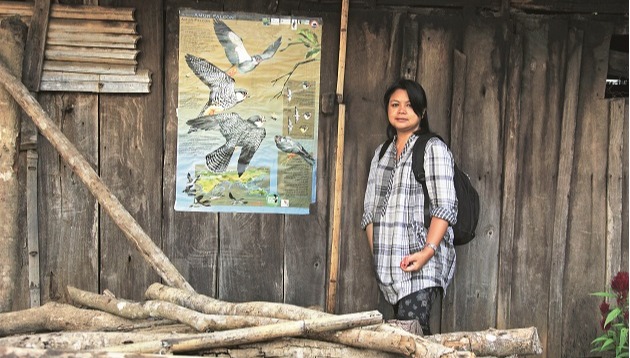
WILDLIFE SERVICE AWARD Bano Haralu’s exceptional conservation initiatives, most notably the protection of migrating Amur Falcons in her native state of Nagaland, have shaped one of the country’s most successful conservation projects in recent times. Photo: Ramki Sreenivasan.
I first met Bano Haralu, a pioneering award-winning television journalist from Northeast India during the infamous cyclone Aila. We became friends, and she invited some of us to visit Nagaland, a part of the world we had only dreamt about. A few of us went, not once but several times, and at the behest of the Government of Nagaland conducted a wildlife survey for the Forest Department leading to the publication of the book Birds of Nagaland authored by Sumit Sen, Ramki Sreenivasan and myself.
After two decades of working with both state and private broadcast media, namely Doordarshan and New Delhi Television, Bano returned to her home state in 2010 and set up the Nagaland Wildlife and Biodiversity Conservation Trust. In 2011, she coordinated a survey to determine the status of wildlife in the state for the Forest Department in eight locations across the state. During the survey camera traps were used for the first time in the state. One of the clear threats to wildlife was the absence of wildlife conservation education awareness programmes amongst the communities across the state.
In October 2012 this fact took on a life-sized canvas as she led a team from Conservation India to Pangti village near the Doyang Reservoir under Wokha district, Nagaland. Here, the team uncovered the massacre of thousands of migrating Amur Falcons.
What followed was a string of meetings with leaders of the villages of Pangti, Pungro and Okhtosto, appointments with the Chief Minister and at the Chief Minister Office, as well as with the Wildlife Wing of the Forest Department and the district administration. These efforts paid off when the Pangti Village Council announced a ban on the killing and trapping of the Amur Falcons under its jurisdiction on the eve of the migratory season in 2013. The same year a team of scientists from Hungary assisted by the Wildlife Institute of India, arrived in Pangti to satellite tag three birds. That year Nagaland earned the title of ‘Falcon capital of the world’.
It was exceedingly clear that an awareness programme was required to stem the scale of hunting, and so Bano and her team spearheaded the ‘Friends of the Amur Falcon’ campaign. For this they adopted ‘Under the Canopy’, a manual that provides a window to wildlife education in Northeast India. With support from the Bombay Natural History Society, Wildlife Conservation Society, Wildlife Conservation Trust and Raptor Research and Conservation Foundation, three Eco Clubs with 80 students from the ages of nine to 11 were established in 2013. Since then the Eco Clubs have increased to four, covering the villages of Sungro, Pangti, Okhtoso and Doyang and students continue to be taught by a team of educators who regularly undergo an annual refresher course with qualified resource persons. There has also been engagement with the community on alternate livelihood means, with home-stays as an immediate and viable option.
An intelligent, committed trailblazer, Bano is a pillar of conservation in India who has crafted one of the country’s most staggering conservation success stories.
By Bikram Grewal, author and publisher
Tahir Shawl and Nazir Malik
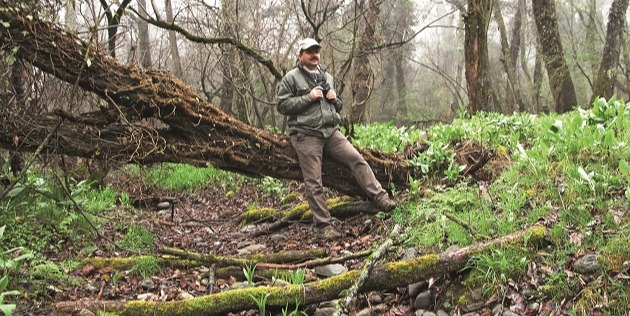

WILDLIFE SERVICE AWARD Champions of the exquisite wildlife of India’s northernmost state, Tahir Shawl and Nazir Malik’s steadfast commitment to the preservation and protection of Kashmir’s Dachigam National Park is second to none. Photo: Cara Tejpal and Nazir Malik.
In a paradise called Kashmir, there is a place even more beautiful. Forester Nazir Malik is its bard, narrating the story of Dachigam National Park. Nazir knows Dachigam as intimately as a lover… and every time he walks the forest, it is as though he has begun the affair anew, brimming with excitement as he lures you into his forest. His voice swells with pride as he speaks of the hangul – Dachigam is the only place in the world to offer sanctuary to this rare, exquisite red deer; softens when he recalls meeting his favourite animal – the Himalayan black bear; dips when he worries about the threats that loom overhead. Nazir recognises all the birds in the park, and is equally well-versed in its flora. He first walked the park as a child, and he has never stopped. His commitment to Dachigam is stoic; even refusing promotions, when they took him away from his beloved forest. Nazir freely shares his knowledge with anyone who is interested, and his childlike wonder is addictive. He inspires, and makes you fall in love. You leave, only to come back again, now, a warrior for Dachigam.
Tahir Shawl’s love for wildlife runs as deep – he has shepherded the realms of some of the country’s rarest wildlife, from the snow leopard in Hemis National Park to the Black-necked Cranes and kiangs on the Indo-Chinese border. He currently heads Dachigam as its Field Director. Tahir is student of the wilds. In his quest to understand, and conserve wildlife, he has studied the endangered Tibetan antelope, tracked the migratory paths of cranes and other waterfowl. He is a fierce protector, working to give the hangul a new lease on life, and marshalling political support to ease pressure on Dachigam from graziers, whose sheep take over the hangul meadows, and to relocate the sheep farm which lies in its core. He once rescued a critically-injured snow leopard from a harried crowd, bundled it into a vehicle, kept it in his official residence, and tended to it till it recovered and could be released back in its snowy realm. His resilience is legendary and perhaps the only thing that stands between Dachigam and its destruction.
By Prerna Singh Bindra, author and journalist
Green Teacher Award
Ambika Khare and Devidutta Chaturvedi
.jpg)
GREEN TEACHER AWARD Ambika Khare and Devidutta Chaturvedi have forwarded the cause of tiger conservation by molding generations of nature-lovers around the Panna. Photo Courtesy: Panna Tiger Reserve Forest Department.
From the time of its inception in 2010-11, the Panna Nature Camps have been conducted assiduously by Panna residents – 84-year-young Ambika Khare and 74-year-young Devidutta Chaturvedi, both retired school teachers.
Ambika sir, as he is fondly called, taught mathematics, science and English. An educationist to the core, even today a school is run within his extended house premises in Panna town. Devidutta sir taught Sanskrit, Hindi and also was responsible for the scouts and guides. The two have an old connection, that of teacher and student – Devidutta sir was a student of Ambika sir’s. Their relationship dates back to the 1950s and they continue to work as a team even today.
Devidutta sir regularly visits schools in the area to ensure that the children are keeping water for the birds in summer, have planted saplings and are taking care of them, recycling paper, not throwing away waste, avoiding the use of plastic, and using electricity judiciously. The proactive measures of these students warms their hearts and gives them the energy and inspiration to continue. Despite their age, their enthusiasm is infectious and their love and curiosity for nature unending as they continue to engage with the education of Panna’s children. Being well aware of their advancing years, they have spent the past two years training Manish Rawat and Bhavani Patel to carry their noble work forward.
The programme pays them a stipend of INR 700 per camp, however they say, “Humko na daam chahiye na naam, hum chahte hain karna keval kaam” (We don’t want money nor fame, we just want to work). These inspiring men have nurtured generations of young naturalists, and are the foundation upon which Panna thrives.
By Peeyush Sekhsaria, amateur naturalist, co-author Our Tiger’s Return
Young Naturalist Awards
Dhruv Prajapati
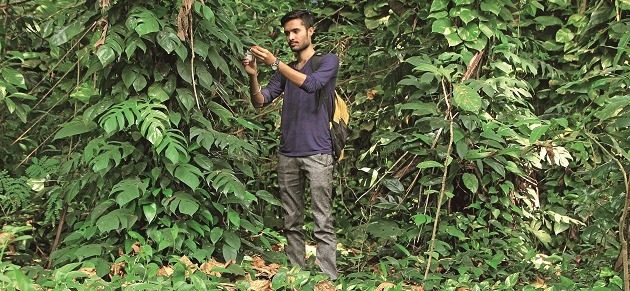
YOUNG NATURALIST AWARD Dhruv Prajapati’s extraordinary commitment to arachnological research in India has won him the support of many a mentor, and enabled him to describe several new spiders from the country. Photo: Albin Mathew.
Naturalists are a rare breed and I suspect that they may soon become extinct. But then you meet an exception like Dhruv, a young man pursuing his passion while getting a doctorate degree. Extraordinary when you consider that most naturalists like me have an aversion to academia! With well over 1,500 species of spiders and at least a dozen new species added each year from India, it is evident that we have just begun exploring our biodiversity and contributions from young investigators like Dhruv are going a long way. At the age of 24, Dhruv has credible publications in mainstream international journals like Zootaxa and the Journal of Threatened Taxa. Gujarat has long been neglected by most researchers with regards to the biodiversity the state hosts, and thus Dhruv’s work has been seminal. During research for his Master’s dissertation on the spiders of the Gujarat University campus, he found 77 species, some of which are rare and not previously reported from the state. The conservation of a species is only possible if one knows of its existence and researchers like Dhruv lay the baseline for conservation by introducing new species to the world through his dedicated efforts in the field and more so in the daunting task of lab work and reviewing literature. Dhruv already has the discovery of six new spider species to his credit, two of which belong to the genus Cambalida from the rare ant-mimicking spider family (Corinnidae), reported for the first time from India.
By Zeeshan Mirza, Member, IUCN Spider and Scorpion Specialist Group
Akshay Khandekar
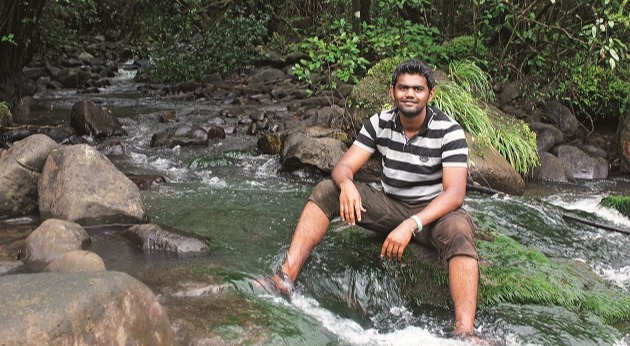
YOUNG NATURALIST AWARD With a keen focus on the systematics of blind snakes, Akshay Khandekar’s sheer hard work has won him the respect of some of the country’s most distinguished herpetologists. Photo: Ninad Gosavi.
Indian herpetology, a field that was neglected until recently, has seen an influx of youth in recent years. Most of them are fascinated by ‘circumstantial situations’ inspired from hosts of sensational TV shows. They frequently end up catching or photographing snakes under the pretext of snake studies. Catching a snake, big or small, is not herpetology but knowing them to the core, with a focused attitude is! In this scenario, Akshay Khandekar is certainly the odd youth out!
Blind snakes are small, not very colourful, rarely seen, burrowers and less-charismatic, and hence are poorly studied. A large proportion of these serpents are not yet known to science globally. Although from a rural setup with mediocre educational and research background, Akshay is studying the blind snakes of India with exceptional focus and dedication. This is a herculean task as our present knowledge of these snakes is largely based on anecdotal studies and historical literature.
Akshay is not only paving his path through his aptitude but also by putting an equal amount of his efforts into backbreaking fieldwork, meticulous bibliographical research and much-needed taxonomic studies.
Although a beginner, Akshay has a good understanding of amphibians and reptiles from various habitats. He is presently doing his research in Dr. Praveen Karanth’s lab at the Centre for Ecological Sciences, Indian Institute of Science, Bengaluru. Akshay is undoubtedly one of the best upcoming researchers in the field of Indian herpetology and a role model for the many young men and women who yearn to pursue a career in Indian herpetology.
By Varad Giri, Post-Doctoral Fellow, National Centre for Biological Sciences
Vineeta Yadav
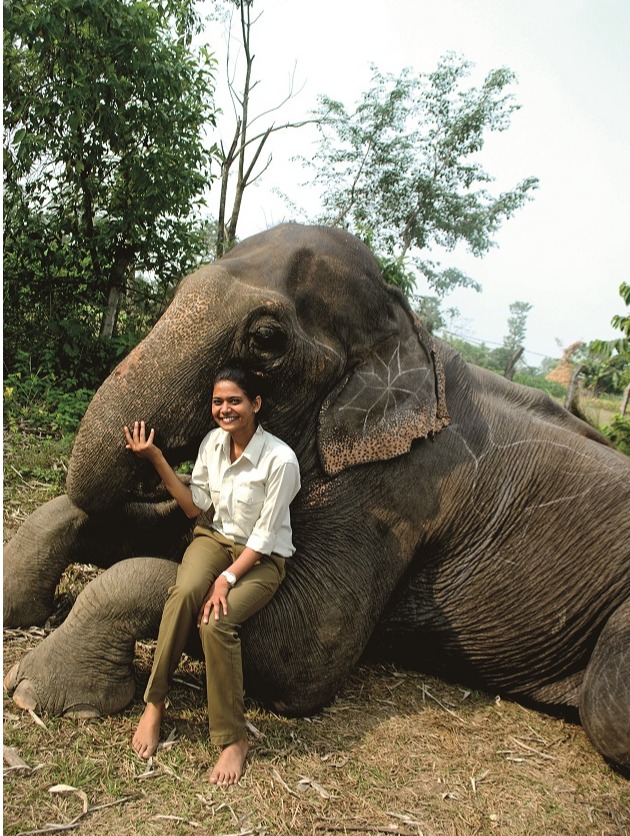
YOUNG NATURALIST AWARD As a young woman naturalist, Vineeta Yadav has shredded existing stereotypes and empowered those around her through her work. Photo Courtesy: Chinmay Deshpande.
When 22-year-old Vineeta Yadav arrived at the Pugdundee Safaris lodge in Nepal’s Chitwan National Park as a naturalist, the management had little idea about the waves she was going to make. For the first month, she was a novelty specimen – gawped at by forest staff and villagers, who were unused to seeing a woman take the lead, as she drove the safari vehicle around the community forests and introduced tourists to its delights. Intent on assimilating, Vineeta intuited that the first barrier she would have to cross was that of language. So she befriended communities and colleagues, and persuaded them to teach her Nepalese. As her language skills improved, she turned to the mahouts of the Elephant Camp to take her on as an apprentice and was soon spending all her free time with them and their mammoth wards. As her bond with the gentle giants blossomed, she worked to improve elephant upkeep, and established a Standard Operating Procedure for their welfare.
Dismayed by the portrayal of Nepal after the 2015 earthquake and the consequent slump in tourism, she convinced lodge management to join the ‘Safe To Travel Nepal’ campaign and began capacity building workshops for local talent. From teaching computer skills, to English and First Aid, these workshops empowered 50 individuals from the community. Even as Vineeta worked on social issues, she continued to hone her skills as a naturalist by attending training programmes and religiously walking in the wilds. A social-worker, naturalist and writer, she is currently pursuing an MBA in Business Sustainability from TERI University.
On clear nights, Vineeta Yadav would take tourists in Chitwan to see the camp’s elephants as they slept under a canopy of stars. The stillness of those nights and the peaceful slumber of the elephants – her reward for a long day’s work.
By Cara Tejpal, Assistant Editor, Sanctuary Asia
Wind Under the Wings Award
Tejdeep Kaur Menon and the TelAngana State Special Protection Force
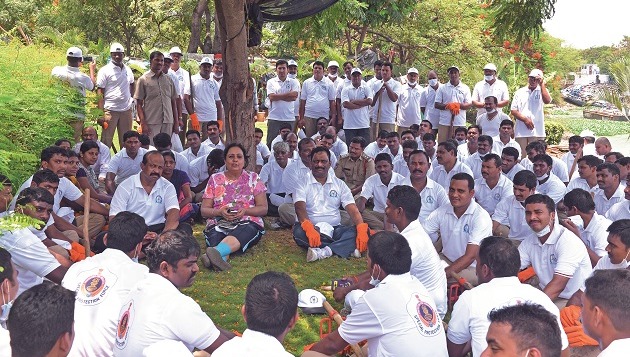
WIND UNDER THE WINGS AWARD With the support of the Telangana State Special Protection Force, Tejdeep Kaur Menon has spearheaded exceptional initiatives to protect urban waterbodies and related biodiversity, particularly avians and aquatic species. Photo Courtesy: Tejdeep Kaur Menon.
Poetry is part of the eco-arsenal of this enterprising police officer whose unstinted efforts, leadership and innovative solutions have helped revitalise a vital lake system in Telangana.
Tejdeep Kaur Menon, an IPS officer of the 1983 cadre, has served in several capacities, beginning her career as an Assistant Superintendent of Police to rising up to her current role as the Director General of Police with the Telangana State Special Protection Force (TSSPF) and the Commissioner of the Government Printing and Stationary Departments. She is the first woman officer to be appointed as the DIG of Police of a range in the state. A vocal advocate of women’s rights, she has been particularly passionate about fighting crimes against women. Equally deft at wielding the pen, she has published four poetry anthologies with the core theme of women’s empowerment and nature conservation. Passionate about social and environmental issues, her crusade to save the Ameenpur lake has now become the stuff of legend. On discovering the utter degradation of the lake near the Telangana Special Protection Force Training Academy, she swiftly undertook a multi-pronged approach that focused on bringing the community together to clean and protect the lake ecosystem. Says Tejdeep, “The Ameenpur lake faced a barrage of assaults in the form of fishing, encroachment, illegal constructions, pollution, water extraction through bore wells, tankers, sand and granite quarrying. I embarked on a series of interventions, systematically tackling one problem at a time.” Tejdeep began by first motivating her own staff – TSSPF personnel – to become ecovolunteers and work along with local NGOs Hyderabad Birding Pals (HBP) and Friends of Flora and Fauna (FoFF) Society during the weekends to pick up litter and educate locals. She petitioned the District Collector to allow the TSSPF to adopt the lake and the adjoining village. Through orientation sessions for fishermen and villagers, TSSPF cajoled them into adopting remedial programmes. They initiated a daily waste collection along with the village panchayat and introduced health screening camps to highlight their high exposure to pollutants. Slowly but surely, villagers began to appreciate their efforts and made a commitment to protect the avian and aquatic life of the lake. TSSPF then stood up to polluting industries that dumped their waste in the lake and had virtually blocked the inlet channels. With the help of the police and the Water Supply and Sewerage Board, they stopped unscrupulous operators from drilling bore wells and installing pump sets. They also used the Telangana State Pollution Control Board, who sampled and tested the water and recommended setting up sewage treatment plants with funds provided by the industries. The TSSPF also began working with school children to ensure that they understood the vital importance of protecting waterbodies. Tejdeep is now lobbying with several government agencies to help stop rock and sand mining around the lake and to remove encroachers. TSSPF has indeed been the wind beneath her wings in her sustained efforts that have now ensured that Ameenpur lake is the first waterbody in the country to be declared a Biodiversity Heritage Site. Plans are also afoot to bring the lake under Mission Kakatiya, the state government’s flagship project to save waterbodies. For Menon, nothing is more symbolic about the success of her efforts than the return of the flamingos to the lake after several years.
Even as Menon and TSSPF continue to secure Ameenpur’s future, they have begun to replicate their efforts by undertaking similar clean-up campaigns at the Fox Sagar lake and in the Anantagiri Hills. TSSPF and Tejdeep Menon have clearly shown that change for the better is possible… one only has to be the change.
By Lakshmy Raman, Executive Editor, Sanctuary Asia
Special Maharashtra Wildlife Awardees
Shree Bhagwan
.jpg)
An Indian Forest Service Officer of Maharashtra cadre, 1981 batch, Shree Bhagwan has worked with almost all the wings of the Forest Department across a career spanning more than 35 years. Having worked in Gadchiroli district for more than six years in the initial years of his service, and as the Additional Commissioner, Tribal Development, Nagpur, he has remained sensitive to the rights of tribals. Along with his colleagues, Bhagwan was responsible in the late nineties for bringing about a change in attitudes and ushering in a new regime of administration in the greater Tadoba landscape with several protocols that are in place even today. He today serves as the Principal Chief Conservator of Forests (Wildlife) and Chief Wildlife Warden of Maharashtra state.
Atul Rambhau Deokar
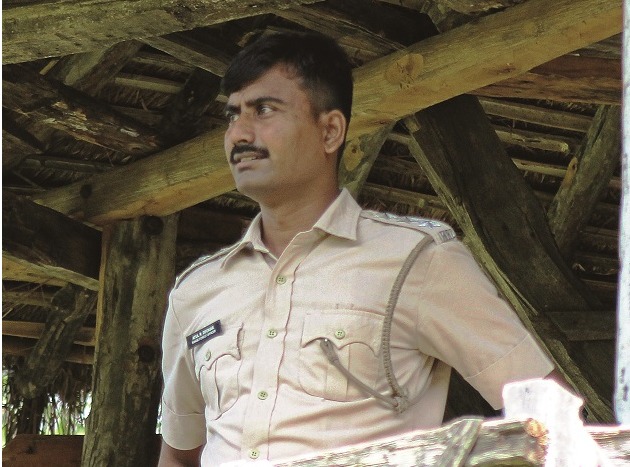
Atul Deokar had the opportunity to extensively study the secret life of the elusive Asiatic wild buffalo Bubalus arnee while he was posted at the Kolamarka Conservation Reserve in Gadchiroli district as Range Forest Officer. When Naxalite activity prevented forest staff from carrying out their duties, the government decided to involve local communities in wildlife conservation. It was during this time that Deokar established Eco-development Committees in four villages through which he focused on water conservation works, critical in conserving the wild buffalo population. He was the first to photograph and monitor movement of 16 wild buffalo individuals by deploying a monitoring team of tribals and exploring the reserve with the help of geo-tag cameras. Due to his efforts, the wild buffalo population in the region has reached 22 from merely two herds comprising 10 individuals. He was instrumental in the conservation of the endangered White-rumped and Indian vultures and established ‘vulture restaurants’ at seven villages with the help of Gidhad Mitras (friends of the vulture), which resulted in the increase in vulture population from three to 250 in Sironcha division. He also identified 1,029 nests of the Indian giant squirrel, the state animal of Maharashtra, in the Kamlapur and Kolamarka Conservation Reserve area, which now boasts of the highest population of these upper-canopy dwelling species in Vidarbha. He has identified and photographed some rare butterflies and added three new species to the checklist of central India. Presently posted at the East Pench Range of the Pench Tiger Reserve in Maharashtra, Deokar continues to perform his duties impeccably.
Surajpal Gorelal Belkar
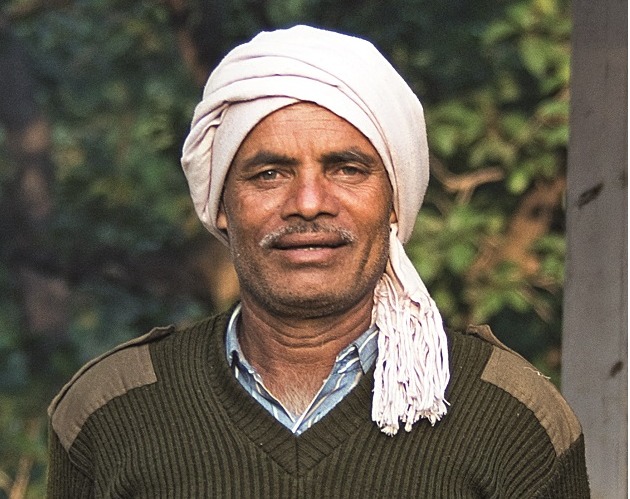
In one of the remotest areas of the Melghat Tiger Reserve, one van majdoor has been unflinchingly patrolling his beat for the past 25 years. Koktu in Gugamal Division of the Reserve, may seem to be a wild paradise for visitors, but surviving there is no easy task, as Surajpal, who must travel 50 km. to get ration, will testify. Back in the day, Surajpal used to patrol on horseback, a practice he had to unfortunately give up after his horse Badal was killed by a tiger. Surajpal is a living encyclopaedia, and is immensely knowledgeable about every little and large creature in his forest. He has accumulated the most amazing stories over the years, including the one time when he nabbed poachers and locked them in his stable for two days until senior officers could reach Koktu in the monsoon, when it was completely cut off from other parts of the reserve. Despite suffering personal and family tragedies as a result of staying in a remote area, this brave man, who has served under many Field Directors, has only one wish – to retire from the Department from his beloved Koktu.
By Anirudh Nair, Assistant Editor, Sanctuary Asia
Sawan Bahekar
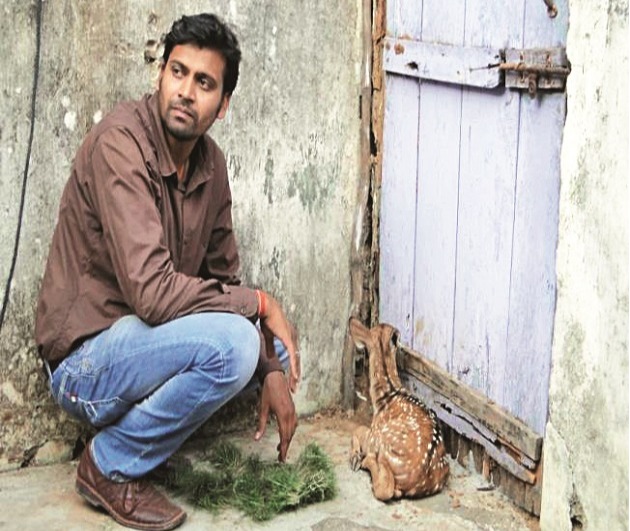
Sawan Bahekar is truly a wildlife defender par excellence. He serves as the Honorary Wildlife Warden of Gondia district and as the president of Sustaining Environment and Wildlife Assemblage (SEWA), a wildlife NGO based in Gondia. He has been instrumental in providing assistance to the Forest Department in wildlife crime investigations and helps gather intelligence on criminal networks. His keen observation, studies and understanding on tiger dispersal and migration have greatly contributed to the tiger conservation monitoring exercises in Maharashtra. He is especially known for the incredible conservation work that saw the revival of Sarus Cranes, whose population had come down to a perilous four individuals in 2003-04, with only four of those found in Maharashtra. After years of committed conservation efforts, today, thanks to Sawan and SEWA, almost 37 Sarus Crane individuals have been recorded in the state. He has been also working with the Forest Department to control habitat encroachment, mitigate human-animal conflict, control forest fires and is a defacto forest official, without being officially appointed as one!
By Purva Variyar, Assistant Editor, Sanctuary Asia







.jpg)




.jpg)


